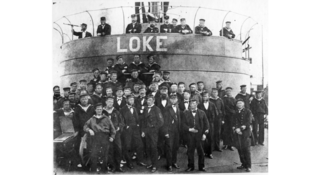
A monitor is a relatively small warship that is neither fast nor strongly armored but carries disproportionately large guns. They were used by some navies from the 1860s, during the First World War and with limited use in the Second World War.
Nine ships and a naval base of the Royal Navy have been named HMS Neptune after the Roman god of the ocean:

HSwMS Sölve is one of seven Hildur-class monitors built for the Swedish Navy in the mid-1870s. The ship had an uneventful career and was sold in 1919 for conversion into a barge. She became a museum ship in Gothenburg, Sweden, in 1992.

HSwMS Garmer was a small river monitor built for the Swedish Royal Skerry Artillery in the mid-1860s. She was designed to operate on the Swedish canals and lakes as well as in the shallow waters of the coast. The ship's captain had to steer the ship as well as aim and fire her gun. Garmer was sold for scrap in 1893.

The John Ericsson-class monitors were a group of five iron-hulled monitors; four were built for the Royal Swedish Navy and one for the Royal Norwegian Navy in the mid to late 1860s. They were designed under the supervision of the Swedish-born inventor, John Ericsson, and built in Sweden. Generally, the monitors were kept in reserve for the majority of the year and were only commissioned for several during the year. The ships made one foreign visit to Russia in 1867 but remained in Swedish or Norwegian waters for the rest of their careers. Two of the monitors, Thordon and Mjølner, ran aground, but were salvaged and repaired. Most of the monitors were reconstructed between 1892 and 1905 with more modern guns, but one was scrapped instead as it was not thought cost-effective to rebuild such an old ship. The surviving ships were mobilized during World War I and sold for scrap afterwards.

HSwMS John Ericsson was the lead ship of the John Ericsson-class monitors built for the Royal Swedish Navy in the mid-1860s. She was designed under the supervision of the Swedish-born inventor, John Ericsson, and built in Sweden. John Ericsson made one foreign visit to Russia in 1867, but remained in Swedish or Norwegian waters for the rest of her career. The ship was reconstructed between 1892 and 1895, but generally remained in reserve. She was mobilized during World War I and sold in 1919 for conversion to a barge.
HSwMS Thordön was the second ship of the John Ericsson-class monitors built for the Royal Swedish Navy in the mid-1860s. She was designed under the supervision of the Swedish-born inventor, John Ericsson, and built in Sweden. Thordön made one foreign visit to Russia in 1867, but remained in Swedish or Norwegian waters for the rest of her career. The ship was reconstructed between 1903 and 1905, but generally remained in reserve. She was mobilized during World War I, and sold in 1922 for conversion to a barge.
HSwMS Tirfing was the third ship of the John Ericsson-class monitors built for the Royal Swedish Navy in the mid-1860s. She was designed under the supervision of the Swedish-born inventor John Ericsson, and built in Sweden. Tirfing made one foreign visit to Russia in 1867, but remained in Swedish or Norwegian waters for the rest of her career. The ship was reconstructed between 1903 and 1905, but generally remained in reserve. She was mobilized during World War I and sold in 1922 for conversion to a barge.

HSwMS Loke was the fourth, and last, ship of the John Ericsson-class monitors built for the Royal Swedish Navy in the late-1860s. Completed in 1871 she only made seven short cruises before she was permanently placed in reserve in late 1880. Funds were requested to reconstruct her in line with the other monitors, but were denied. She was listed for sale in 1908, but nothing is known of her fate.

HNoMS Mjølner, named after the hammer of the god Thor, was the fourth of five ships of the John Ericsson-class monitors built for the Royal Swedish Navy and the Royal Norwegian Navy in the mid-1860s. Influenced by the use of ironclads during the American Civil War, the design was based on that of USS Monitor. They were designed under the supervision of the Swedish-born inventor John Ericsson—coincidentally designer of Monitor—and built in Sweden. Mjølner was delivered in 1868. She ran aground the following year, without serious damage, and reconstructed in 1897 with later breech-loading guns. Mjølner was sold for scrap in 1909.

HSwMS Folke was the last of the seven Hildur-class monitors built for the Swedish Navy in the mid-1870s. Unlike her sisters, her gun turret was fixed to the rear. The ship was placed in reserve in 1919 and ultimately sold in 1942.

Maritiman is a floating maritime museum on the Göta Älv, in Gothenburg, Sweden. The museum's collection comprises 19 vessels, the oldest being HSwMS Sölve from 1875.

The Hildur-class monitors consisted of seven monitors built for the Swedish Navy in the 1870s. They were sold in 1919 and most were converted into fuel oil barges. One such ship, HSwMS Sölve, has been converted into a museum ship.

HSwMS Berserk was one of seven Hildur-class monitors monitors built for the Swedish Navy in the mid-1870s. The ship had an uneventful career and was sold in 1919 for conversion into a fuel oil barge.
Several ships of the Swedish Navy have been named HSwMS Loke, named after Loki in Norse mythology:
Several ships of the Swedish Navy have been named HSwMS Tordön or HSwMS Thordön, named after the Old Norse word for thunder:
Several ships of the Swedish Navy have been named HSwMS Tirfing, named after Tyrfing, a magic sword in Norse mythology:
This page is based on this
Wikipedia article Text is available under the
CC BY-SA 4.0 license; additional terms may apply.
Images, videos and audio are available under their respective licenses.








